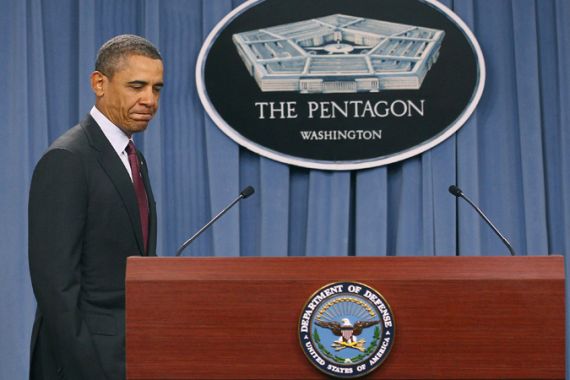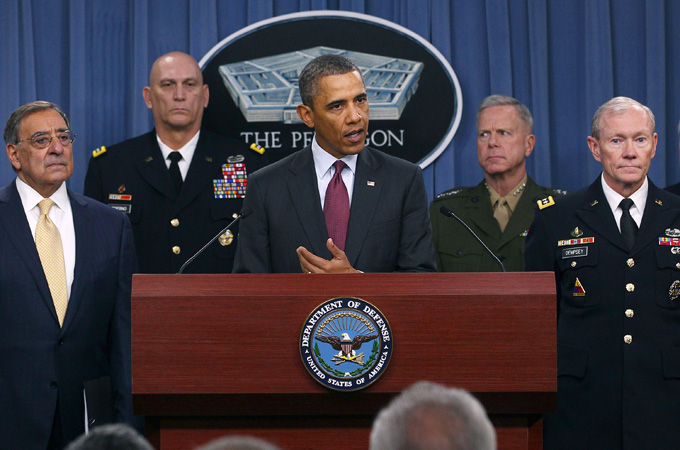Less counter-insurgency, more Asia
President Obama’s new defence strategy focuses on reducing military spending while turning attention eastwards.

 |
| Reactions to President Obama’s new defence strategy have been mixed: hawks say the reduced military will be unable to meet threats, while more dovish voices say proposed budget cuts are not enough [GALLO/GETTY] |
Washington DC, United States – Capping a major eight-month review, President Barack Obama unveiled a new defence strategy here on Thursday that places more emphasis on US military capabilities in Asia and the Pacific and much less on counter-insurgency and nation-building operations in poorer and conflict-plagued countries.
Among other steps, the new strategy paper, “Sustaining US Global Leadership: Priorities for 21st Century Defense”, calls for new investments in cyber-security and greater reliance on naval and air power, as opposed to ground forces, whose ranks will be reduced by tens of thousands over the coming few years.
“As we look beyond the wars in Iraq and Afghanistan – and the end of long-term nation-building with large military footprints – we’ll be able to ensure our security with smaller conventional ground forces,” Obama said at an unprecedented presidential briefing at the Pentagon.
“… So, yes, our military will be leaner, but the world must know the United States is going to maintain our military superiority with armed forces that are agile, flexible and ready for the full range of contingencies and threats,” he added.
|
Obama presents plan for ‘leaner’ US military |
The new strategy, which Obama ordered the Pentagon to prepare last April, is designed to accommodate some 450 billion dollars in cuts in projected defence budgets over the next ten years.
Because of the failure last November of a bipartisan Congressional “super-committee” to reach agreement on how to reduce the record trillion-dollar deficits that Washington faces, the Pentagon may be forced to cut as much as an additional 600 billion dollars over the decade.
At more than 700 billion dollars in 2012, the US defence budget accounts for over 40 per cent of total annual global military spending and exceeds the combined defence budgets of the world’s 20 next most-powerful militaries.
Even with the ten-year, 450-billion-dollar cut on which the new strategy is based, however, Obama said the Pentagon’s budget will continue “to be larger than roughly the next ten countries combined” and “will still grow, because we have global responsibilities that demand our leadership”.
Much of the savings will be borne by the reductions in ground forces, of which the army is likely to be the biggest loser. While specific details of cuts are expected to be announced later this month or in early February, the army’s ranks are likely to decline from the current 570,000 soldiers to 490,000 in the coming few years, according to senior Pentagon officials.
Moving east
The Marines, currently more than 200,000 strong, will be hit much less hard, as they are likely to be assigned to naval task forces whose importance will increase as a result of the administration’s strategic “pivot” from the Greater Middle East towards the Asia-Pacific region that was dramatised by Obama’s November swing through the region.
Indeed, it was during that tour that he announced the deployment 2,500 Marines to a base in northern Australia in what the New York Times called “the first long-term expansion of the American’s military’s presence in the Pacific” since the Vietnam War.
That geographical pivot was re-affirmed in the new strategy document, which described US economic and security interests as “inextricably linked” to the region. “Accordingly, while the US military will continue to contribute to security globally, we will of necessity rebalance toward the Asia-Pacific region,” it declared.
Other savings are likely to come from delays or cancellations of costly new weapons systems, most notably the nearly 2,500 F-35 Joint Strike Fighters (JSF) ordered by the Pentagon. The Lockheed-Martin programme has been plagued by huge cost overruns, making it the most expensive defence programme in US history.
The strategy also suggests cuts in US nuclear forces. “It is possible that our deterrence goals can be achieved with a smaller nuclear force, which would reduce the number of nuclear weapons in our inventory as well as their role in US national security strategy,” the strategy paper asserted.
The strategy also suggested that Washington is abandoning its post-Cold War stance that it should be able to fight two major ground wars in different parts of the globe at the same time.
|
On Al Jazeera’s Inside Story: |
“Even when US forces are committed to a large-scale operation in one region, they will be capable of denying the objectives of – or imposing unacceptable costs on – an opportunistic aggressor in a second region,” the document states.
That was criticised by the Republican chairman of the House Armed Services Committee, Representative Bud McKeon, who called it “unrealistic”.
“The president is clearly repeating the mistakes of the past – by providing a force far smaller than is sufficient to meet the threats we face,” he told editors at the neo-conservative American Enterprise Institute (AEI). “The possibility of two simultaneous contingency operations is real. One need only look at the current instability in North Korea and the threats coming from Iran, for an example.”
Doves vs hawks
McKeon also complained that the reduction in ground troops will put the US “back on a pre-9/11 footing” and that “the next time we have to engage in a major ground operation, we won’t have the forces we need, just as we didn’t in Iraq and Afghanistan.”
Similarly, Jamie Fly, the executive director of the hawkish Foreign Policy Initiative (FPI), described the strategy’s rejection of counter-insurgency and nation-building as “very dangerous”.
“I understand that most Americans are tired of prolonged commitments in war zones, but the fact of the matter is we never know what’s over the horizon,” he explained. “Stating up front that our forces are going to be incapable of conducting these types of operations is very risky.”
If the hawks were unhappy, however, more dovish voices were decidedly muted in their enthusiasm.
“The Pentagon’s proposed reductions in its spending plans are far too low,” according to William Hartung, a veteran defence analyst at the Washington-based Center for International Policy.
“If the administration were to follow up on its own rhetoric on smaller conventional forces, getting rid of outdated Cold War-era systems, and reduce our nuclear forces, it could double its proposed cuts in Pentagon spending to one trillion dollars over the next decade. That would be a real down payment on reductions that need to be made to have a significant impact on reducing future deficits,” he said.
|
“The Pentagon’s proposed reductions in its spending plans are far too low.“ – William Hartung, defence analyst |
“This is an extremely modest build-down,” said Miriam Pemberton of the Institute for Policy Studies, who noted that the anticipated 2013 Pentagon budget that Obama will request in his State of the Union Address to Congress later this month will amount to only four per cent less than the previous five-year average.
Even as the strategy review re-affirmed Obama’s “pivot” to the Asia/Pacific, it also stressed its continued commitment to the Greater Middle East, noting US goals of “countering violent extremists and destabilising threats”, particularly “prevent[ing] Iran’s development of a nuclear weapon capability and counter[ing] its destabilising policies”.
“To support these objectives, the United States will continue to place a premium on US and allied military presence in – and support of – partner nations in and around this region,” it asserted in italics.
“Those allies in the Persian Gulf should rest easier after today’s press conference,” noted Andrew Exum, senior fellow of the Center for a New American Security (CNAS).
In remarks late last month, after Washington completed the withdrawal of all its combat troops from Iraq, Ben Rhodes, Obama’s deputy national security adviser, sparked considerable speculation over the continued US military presence in the region when he told reporters that the US would seek to “demilitarise” its presence there by returning to a “posture … far more in line with where we were before 1990.”
Follow Jim Lobe, Washington bureau chief of IPS News, on Twitter: @LobeLog
A version of this article was first published on Inter Press Service.